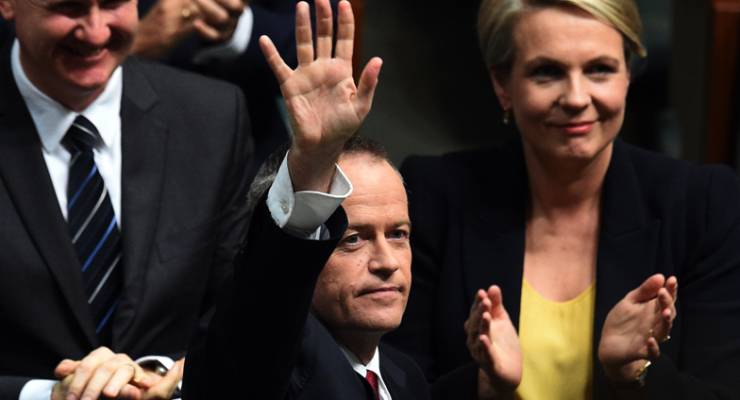
As the official election campaign finally gets under way, Opposition Leader Bill Shorten finds himself in a position where a victory for Labor on July 2 can be seriously discussed, even if few would go so far as to rate it an active probability.
Four opinion polls conducted after the budget and published over the past few days have each recorded a statistical dead heat, with Newspoll giving Labor a two-party lead of 51-49, Ipsos having it the other way around, and ReachTEL and Galaxy both coming in at 50-50.
Ipsos also got to 50-50 when it allowed minor party and independent-voting respondents to allocate their own preferences, rather than assuming they would flow the same way as at the 2013 election, while ReachTEL would have leaned a point in favour of the Coalition if they had done the opposite.
While the implications of the budget are perhaps yet to be fully realised, the indications are that it has done nothing to break the two-party stalemate one way or the other.
However, there are good historical reasons to interpret this as meaning that Labor actually starts the campaign slightly behind the eight-ball.
Labor currently holds 55 seats in a lower house of 150, and would be in a position to form a stable government if it made a net gain of 20.
The problem is that most of the seats Labor will need to get there are the very ones that were lost to the Coalition in 2013.
Their new Liberal members have now had three years to establish themselves in their local communities, which will make them just that much harder to remove.
Precisely this dynamic prevented Kim Beazley from consigning the Howard government to history after a single term in 1998, when the Coalition managed to retain 80 seats out of 148 despite losing the two-party preferred vote by a 51-49 margin.
Unless the fortunes of the campaign run decisively in Labor’s favour, Shorten will have to rely on the swing landing precisely where it is needed most.
As has so often been the case in recent history, this principally means Queensland, where 10 seats changed hands with the election of the Howard government in 1996, six went back to Labor in 1998, nine decided the result in favour of Labor under local hero Kevin Rudd in 2007, and six returned to the conservative fold after Rudd was dumped in 2010.
Both leaders are beginning the campaign in earnest by visiting the state today, with Malcolm Turnbull doing the rounds of Brisbane marginals and Bill Shorten headed for Cairns, which dominates the tough but winnable seat of Leichhardt.
Labor strategists are optimistic that Queensland will indeed get them a long way towards where they need to go, particularly in regional areas, where the collapse of Clive Palmer’s Queensland Nickel has been far from the only damage wrought by the end of the mining and resources boom.
For much the same reason, Labor appears to be on the cusp of its first respectable result in Western Australia since the days when local hero Kim Beazley was leader.
Aggregated polling results show the swing to Labor in WA to be twice as high as in any other state, which reflects the extent of Labor’s weakness there during the years of the mining boom as much as the strength of its recent recovery.
With perhaps four seats to be gained, the state is of at least as much strategic interest as Victoria, where not more than three seats have changed hands between Labor and the Coalition at any election since 1990.
South Australia has also been electorally sedate over the last three elections, but has forced the major parties to pay attention to it by threatening to abandon them both for the Nick Xenophon Team.
The seats of regional Tasmania are as finely balanced as ever, with at least two of the three having changed hands at five of the last eight elections, and all three having done so amid Labor’s rout of 2013.
Voters in this region have shown themselves to be acutely sensitive to local economic concerns, a fact that is unlikely to escape the notice of either side over the next eight weeks.
With a bit of wind in its sails, Labor could hope to harvest half a dozen seats in Queensland, four in Western Australia, three in Victoria, two or three in Tasmania and one apiece in South Australia and Tasmania.
But to get over the line from there, a further brace of seats will be required in New South Wales, which could prove to be Labor’s Achilles heel.
Labor in New South Wales continues to pay the price for the corruption scandals and fratricidal internal politics that culminated in the devastating state election defeat of 2011, and it faces a particularly hostile media environment in the state, as The Daily Telegraph once again demonstrated with this morning’s front page.
It also has interstate rivalries to contend with as it tries to pit its Melburnian leader against a lifelong Sydneysider in Malcolm Turnbull.
Labor’s loss of eight New South Wales seats was a cornerstone of its heavy defeat in 2013, among which were two seats in Sydney — Banks and Reid — that were won by the Liberals for the first time in histories going back well over half a century.
Present indications suggest that only a handful of these eight seats are set to return to the Labor fold on July 2.
Unless Bill Shorten can turn that around between now and polling day, a place in the history books as the first leader to dislodge a first-term government since 1931 is likely to elude him.
*To read more from Crikey‘s William Bowe visit The Poll Bludger








I too doubt that Labour can win, but the arithmetic seems a bit off in this artile:
“With a bit of wind in its sails, Labor could hope to harvest half a dozen seats in Queensland, four in Western Australia, three in Victoria, two or three in Tasmania and one apiece in South Australia and Tasmania.”
That’s 17 – assuming 3 in Tas, exluding the repeated extra mystery seat for Tas.
In NSW “a handful of these eight seats are set to return to the Labor fold on July 2.”
If a handful is 3, that’s 20.
In my view Labor will regain 5 seats in NSW (including Eden Monaro); 7 in Queensland; 3 in Victoria (including Corangamite); 2 in Tasmania; 1 in SA and 2 in WA. That’s 20. Add that the current independents will retain their seats and we could see Tony Windsor back. The arithmetic is razor sharp – I believe the campaign will be crucial and here the mantra approach of the coalition together with attack ads loses impact over time. If Labor keeps on pushing “fair to all, steady as she goes we are a team” this will get them over the line. NB Queensland should not be discounted as a possible landslide switch to Labor
LES
I agree, Les. I am sick to death of every commentator and ‘expert’ putting Labor down at every opportunity. Don’t they read the newspaper blogs? Listen to the radio (non shock jock) talk back?
Even the Australian has pro-Labor posters (according to friends who pay and read the Lieberal daily). Far too early to be writing them off IMHO!
All hope rests with the prols in NSW. No Murdoch, no Shorten. And if the Daily Tele headline is anything to go by today……. Hope I’m wrong.
I assume that most of the saner posters here would prefer a minority government which has to negotiate each & every contentious Bill with the Independents (in both Chambers) who are generally thought to be certs.
I, for one, welcome our new Democratic Overlords.
How principled is the Shorten Billed corella – going into Gloria’s cage to share a perch?
Absolutely not!!
That means the country is run by the 10% of Greens/Independents who mostly live in cloud cuckoo land.
The voting public will NEVER accept that arrangement…so more deadlock, more elections, more social unrest.
A recipe for disaster!!!!!
Yes, and that is the correct terminology to use.
Every time you hear “hung parliament”, think “democratic parliament”.
The fans of football-team electoral dictatorship [so long as their team are the dictators] are the people destroying this country.